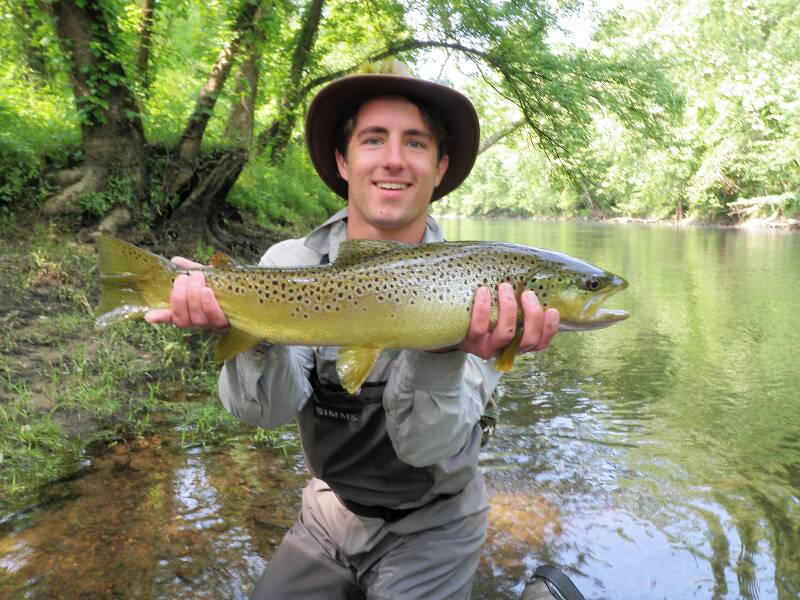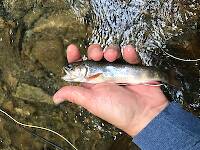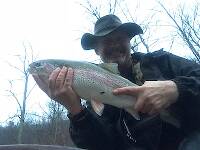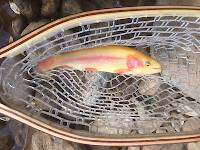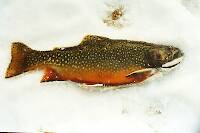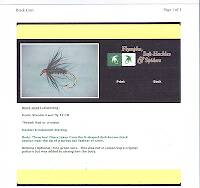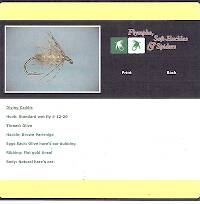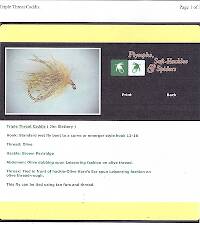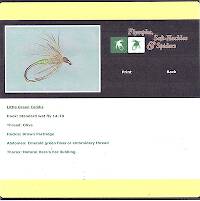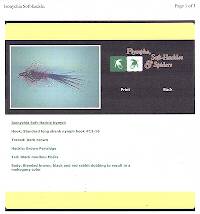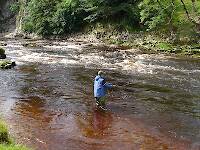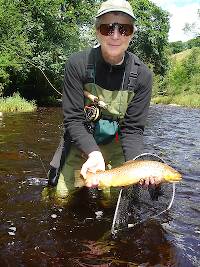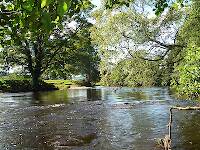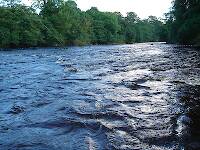
Salmonflies
Pteronarcys californica
The giant Salmonflies of the Western mountains are legendary for their proclivity to elicit consistent dry-fly action and ferocious strikes.
Featured on the forum

This one pretty clearly keys to Kogotus, but it also looks fairly different from specimens I caught in the same creek about a month later in the year. With only one species of the genus known in Washington, I'm not sure about the answer to this ID.

Troutnut is a project started in 2003 by salmonid ecologist Jason "Troutnut" Neuswanger to help anglers and
fly tyers unabashedly embrace the entomological side of the sport. Learn more about Troutnut or
support the project for an enhanced experience here.
Fwol on Apr 18, 2012April 18th, 2012, 6:17 am EDT
DI was wondering if the stock trout diet is different after been releasted.will it eat differently than a native?
Fishin Trouties
Entoman on Apr 18, 2012April 18th, 2012, 9:08 am EDT
Hi Idaho,
Welcome to the forum!
The answer is yes to both questions.
Welcome to the forum!
The answer is yes to both questions.
"It's not that I find fishing so important, it's just that I find all other endeavors of Man equally unimportant... And not nearly as much fun!" Robert Traver, Anatomy of a Fisherman
Cutbow on Apr 18, 2012April 18th, 2012, 12:39 pm EDT
Fwol,
Dittos to Entoman's welcome.
Hatchery fish are kept in a small tank or pool, packed in there by the thousands. They are fed pellets that are tossed in with a scooper. The result is a ton of fish voraciously attacking the pellets becuase they are competing so much with their cell mates. Freshly released hatchery fish will tend to eat whatever is in front of their noses in the same manner.
Thats my theory as to why fresh hatchery trout are often harder to hook.
However, it's been my experience that after about 6 months or so of being in a natural habitat they will learn how to effectively/efficently catch pray. In fact, depending on what type of hatchery fish we are talking about, you might not even beable to tell the difference between a stock and native fish after 6 months or so post release. However this is not true of the Tripoilds we have here in Idaho. Triploids are pale in color and don't seem to live long.
I hope this helps!
John
Dittos to Entoman's welcome.
Hatchery fish are kept in a small tank or pool, packed in there by the thousands. They are fed pellets that are tossed in with a scooper. The result is a ton of fish voraciously attacking the pellets becuase they are competing so much with their cell mates. Freshly released hatchery fish will tend to eat whatever is in front of their noses in the same manner.
Thats my theory as to why fresh hatchery trout are often harder to hook.
However, it's been my experience that after about 6 months or so of being in a natural habitat they will learn how to effectively/efficently catch pray. In fact, depending on what type of hatchery fish we are talking about, you might not even beable to tell the difference between a stock and native fish after 6 months or so post release. However this is not true of the Tripoilds we have here in Idaho. Triploids are pale in color and don't seem to live long.
I hope this helps!
John
"Once you catch your first fish on a fly you won't care about any other kind of fishing!"
Jesse on Apr 19, 2012April 19th, 2012, 6:50 pm EDT
Stocked trout are a lot more opportunistic when feeding, especially upon first being released.
Most of us fish our whole lives..not knowing its not the fish that we are after.
http://www.filingoflyfishing.com
http://www.filingoflyfishing.com
Shanti on Apr 25, 2012April 25th, 2012, 3:44 am EDT
In general, stocked trout are more opportunistic. And as Jesse writes, the first few weeks after beeing released they're learning what is food and what's not.
This depends a lot on how they were farmed, some fish-farms here in Sweden lets the trout feed on natural stuff the weeks before release. And in more natural ponds.
The trout in the stocked lakes where I live pick up a natural behaviour quite fast. Sometimes becoming more difficult to catch than the wild fish.
I have a theory why; Whilst beeing bred on pellets all their lives they have learned to be selective, to single out the main food-source most easy to feed on at the time.
Many times I have had poor results while fishing my stocked lakes, and then stopping by at some wild lakes on the way home and catching more fish there.
Just as an example;
On one of the lakes the stocked fish gets keyed in to flying Odonata, mostly dragonflies, and becoming virtually impossible to catch. At the same time on the wild lakes nearby fish are feeding on the same insect and showing same tendency to jump for flying dragons, but also possible to catch.
This depends a lot on how they were farmed, some fish-farms here in Sweden lets the trout feed on natural stuff the weeks before release. And in more natural ponds.
The trout in the stocked lakes where I live pick up a natural behaviour quite fast. Sometimes becoming more difficult to catch than the wild fish.
I have a theory why; Whilst beeing bred on pellets all their lives they have learned to be selective, to single out the main food-source most easy to feed on at the time.
Many times I have had poor results while fishing my stocked lakes, and then stopping by at some wild lakes on the way home and catching more fish there.
Just as an example;
On one of the lakes the stocked fish gets keyed in to flying Odonata, mostly dragonflies, and becoming virtually impossible to catch. At the same time on the wild lakes nearby fish are feeding on the same insect and showing same tendency to jump for flying dragons, but also possible to catch.
Somewhere, right now, a fish is rising.
And you´re at the computer..
And you´re at the computer..
Jesse on Apr 25, 2012April 25th, 2012, 5:49 am EDT
Joakim, thats an interesting theory bra, i can believe that. I'm not familiar with any practices such as the ones close to you near "stockville" Tennessee. It seems like that would make fishing for stocked trout a lot more interesting ha. Also, if you take them out of the cement tubs and put them into some actual pond areas, it might take away the heavy beating their bodies take in the tub; less deformities maybe.. Interesting stuff though man!
Most of us fish our whole lives..not knowing its not the fish that we are after.
http://www.filingoflyfishing.com
http://www.filingoflyfishing.com
Shanti on Apr 25, 2012April 25th, 2012, 6:36 am EDT
Yes, the way of letting them spend their last "farm-time" in ponds makes them healthier and better looking. The biggest problem we have here with rainbows is inbreeding. No new genes are introduced because of the risk of diseases.
Somewhere, right now, a fish is rising.
And you´re at the computer..
And you´re at the computer..
Fwol on Apr 25, 2012April 25th, 2012, 7:28 pm EDT
Thanks to all that replied and for the welcome
Fishin Trouties
MontanaMike on Apr 29, 2013April 29th, 2013, 12:58 pm EDT
I know stocked trout flourish fine in wild water but they are certainly easy to spot over wild trout. Wild trout have a white strip on the anal and pectoral fins. Most stocked trout, since they are constantly rubbing against their concrete or plastic tanks when young, have portions of these fins rubbed off. Ive caught some stockers that, after 2 years and 17 inches, had half a fin here, or missing a fin there.
It makes sense to me that when fishing for stockers in a lake or tream, a small brown egg or pellet pattern, lol, would do great
It makes sense to me that when fishing for stockers in a lake or tream, a small brown egg or pellet pattern, lol, would do great
Sayfu
Posts: 560
Posts: 560
Sayfu on Apr 29, 2013April 29th, 2013, 2:23 pm EDT
The stocked trout I can get excited about are the triploids. Canada has done a great job stocking triploid rainbows in their lakes. They grow very large, and healthy quite quickly, and are powerful fighting fish that have small heads, and big bodies. I just watched a segment of Brian Chan explaining the program, and catching some of these beautiful fish.
Sayfu
Posts: 560
Posts: 560
Sayfu on Apr 29, 2013April 29th, 2013, 5:56 pm EDT
How do you "hookup a Canadian"? Chan, and the show host of "Fly fishing on the Fly" Don Friski, were Chironomid fishing, and it was fast action. We have a lake not far from me that has the same quality fishing for Triploid Rainbows.
Quick Reply
Related Discussions
Topic
Replies
Last Reply
23
Aug 13, 2014
by Reelin_good
by Reelin_good
23
Oct 3, 2015
by Martinlf
by Martinlf




